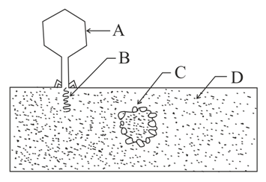Lederberg's replica experiment explains theory.
Important Questions on Construct an explanation based on evidence for how the structure of DNA determines the structure of proteins which carry out the essential functions of life through systems of specialized cells.
Lederberg and Tatum found that the bacterium donates entire genetic material to recipient
Ehrenberg established link between bacteria and infectious diseases
Pasteur showed about the significant changes of nature brought by bacteria
Griffith discovered recipient cells of bacteria acquire previous characters
Identify the labels marked A, B, C, D in a sequence in the illustrated diagram.

Explain one gene, one polypeptide theory.
A student grew virus in three different media containing and DNAase separately and allow this virus to attack to E. coli. The series of observation made by the students are as follows:
a) labelled phage particles were produced in E. coli.
b) containing phage particles were produced E. coli.
c) Phage particles were observed in E. coli.
d) was not observed in phage particles produced by E. coli.
e) was not observed in phage particles produced by E. coli.
The correct observations are
Write any two chemical differences between DNA and RNA.
| Column - I | Column - II | ||
| i | Griffith | p | Lac Operon |
| ii | Jacob and Monad | q | DNA is the genetic material |
| iii | Meselson and Stahl | r | Transforming principle |
| iv | Hershey and Chase | s | DNA replicates semi-conservatively |
A bacterial strain was heat killed. Another strain (living) was taken and mixed with this S strain. This mixture of strains were injected into mice. Which of the following are observed by Griffith?
I. The cells of strain were dead in dead mice.
II. The bacterial cells without polysaccharide coat are transformed into virulent strain in the injected mice.
II. Griffith could not find living strain in the body of dead mice.
IV. Griffith could find living strain in the body of dead mice.
The correct combination is:

